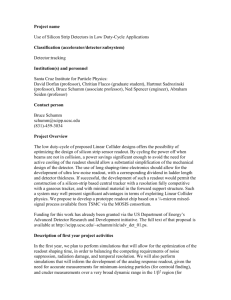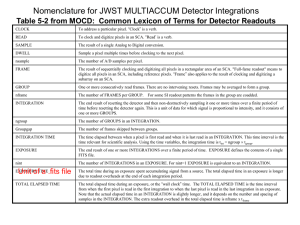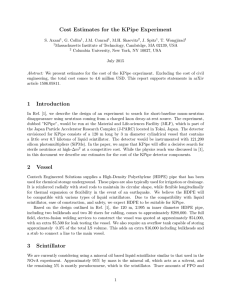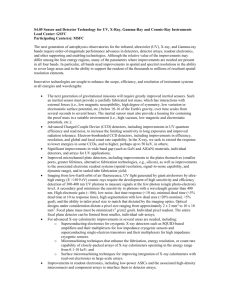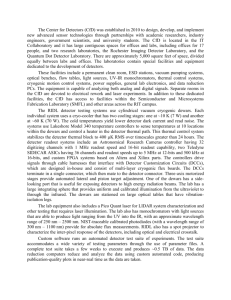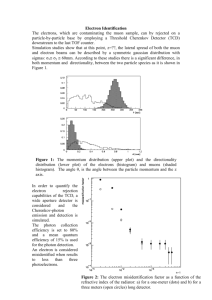Scintillator Based Muon System
advertisement
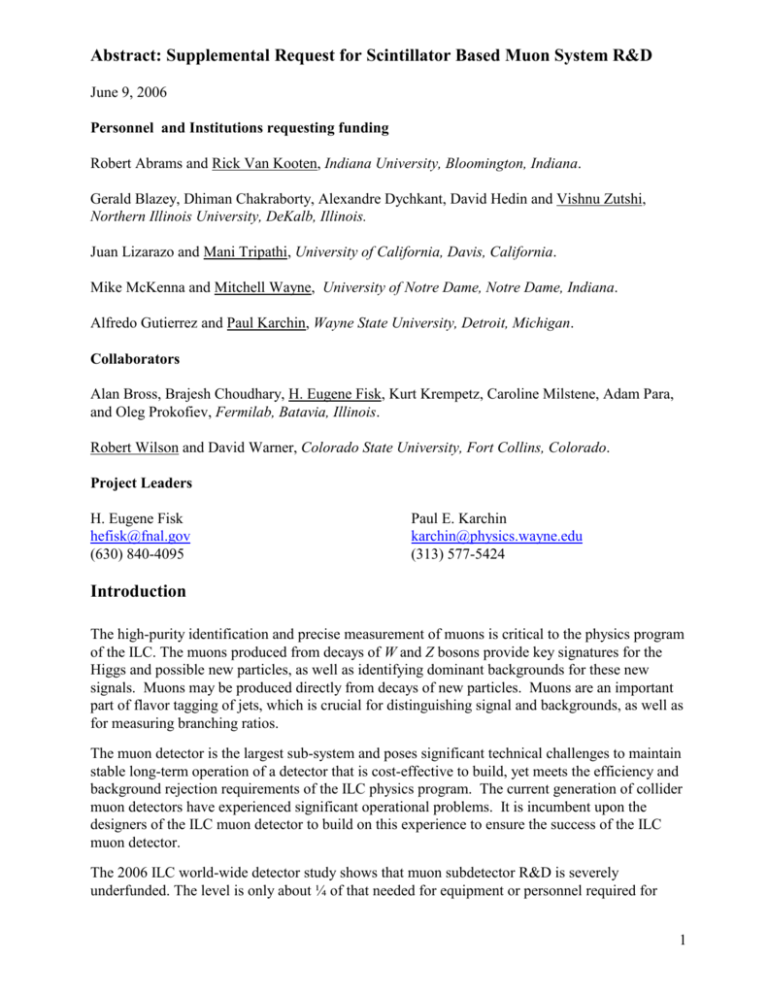
Abstract: Supplemental Request for Scintillator Based Muon System R&D June 9, 2006 Personnel and Institutions requesting funding Robert Abrams and Rick Van Kooten, Indiana University, Bloomington, Indiana. Gerald Blazey, Dhiman Chakraborty, Alexandre Dychkant, David Hedin and Vishnu Zutshi, Northern Illinois University, DeKalb, Illinois. Juan Lizarazo and Mani Tripathi, University of California, Davis, California. Mike McKenna and Mitchell Wayne, University of Notre Dame, Notre Dame, Indiana. Alfredo Gutierrez and Paul Karchin, Wayne State University, Detroit, Michigan. Collaborators Alan Bross, Brajesh Choudhary, H. Eugene Fisk, Kurt Krempetz, Caroline Milstene, Adam Para, and Oleg Prokofiev, Fermilab, Batavia, Illinois. Robert Wilson and David Warner, Colorado State University, Fort Collins, Colorado. Project Leaders H. Eugene Fisk hefisk@fnal.gov (630) 840-4095 Paul E. Karchin karchin@physics.wayne.edu (313) 577-5424 Introduction The high-purity identification and precise measurement of muons is critical to the physics program of the ILC. The muons produced from decays of W and Z bosons provide key signatures for the Higgs and possible new particles, as well as identifying dominant backgrounds for these new signals. Muons may be produced directly from decays of new particles. Muons are an important part of flavor tagging of jets, which is crucial for distinguishing signal and backgrounds, as well as for measuring branching ratios. The muon detector is the largest sub-system and poses significant technical challenges to maintain stable long-term operation of a detector that is cost-effective to build, yet meets the efficiency and background rejection requirements of the ILC physics program. The current generation of collider muon detectors have experienced significant operational problems. It is incumbent upon the designers of the ILC muon detector to build on this experience to ensure the success of the ILC muon detector. The 2006 ILC world-wide detector study shows that muon subdetector R&D is severely underfunded. The level is only about ¼ of that needed for equipment or personnel required for 1 priority-1 topics even though the total cost for muon subdetector R&D is one of the smaller subdetector costs. Scintillator strips with fiber readout is a leading candidate technology for the ILC muon detector. This technology combined with multi-anode photomultiplier tube or solid state photon detector readout is economical yet promises efficient and robust operation. Operation of reduced scale prototype detectors has recently begun at the Meson test beam facility at Fermilab. The detector setup is shown in Fig. 1 and a detailed view of the readout system is shown in Fig. 2. While the initial test beam data is under analysis, an earlier result using cosmic rays shows that the signal produced by the wavelength-shifting fiber is a complex one, as shown in Fig. 3. The magenta trace is from a paddle trigger counter readout by a single anode PMT. The blue trace is from a single scintillator strip embedded with a wavelength shifting fiber. The WLS fiber is fused to a clear fiber which is readout by a single MAPMT channel. The complex structure is attributed in part to the WLS fluor, which responds to individual, independent photon excitations with a characteristic decay time. Goals We propose an expanded R&D effort for a scintillator based muon detector to establish the basis for the technical performance and cost estimate by the end of 2007. Five major areas of R&D are proposed and described below. 1) Test Beam Measurements. While the four planes in M-test are a good start, there are not enough personnel to operate it and analyze the data. We propose to fully characterize the operation of the ¼ size prototype scintillator planes using the Fermilab test beam. We will measure the charge distribution as a function of position along the strip for minimum ionizing particles for each of the 64 strips in each plane. Using strips readout from both ends, we will determine the improvement in efficiency compared to single-ended readout and measure the position resolution along the strip, for strips with double-ended readout. Two of the modules have single-ended readout and two have double-ended readout. 2) Calibration and Monitoring. A bench top system for testing and calibrating phototubes exists at Wayne State. The four prototype modules at Fermilab have a light injection system using light emitting diodes and a light monitoring capability using p-i-n diodes. However, there are not enough personnel and equipment funds to make measurements on all the phototubes and to instrument the in-situ led/pin-d system. We propose to calibrate the 14 MAPMTs already purchased and to build or acquire electronics to operate the in-situ system. Furthermore, we propose to develop hardware and software to automate the calibration and monitoring systems. 3) Solid State Photon Detection. Prototype modules utilizing silicon photomultiplier (SiPM) devices for the tail catcher muon tracker (TCMT) project have undergone initial operation in the Fermilab test beam. However, the mechanical infrastructure for the integrated detector-absorber stack awaits additional resources for mechanical technician personnel. We propose here to complete the detector-absorber assembly and to accelerate efforts to evaluate the performance of solid state photon detectors. We will incorporate a variety of solid state detectors including the geiger-mode device being developed by the Colorado State group and commerical devices becoming available from companies in Italy, Ireland and Japan. We will compare the performance 2 Figure 1. View looking upstream of the ¼ size scintillator muon detector prototype located in the Meson test beam facility at Fermilab. Photograph from January, 2006. Multi-anode photomultiplier tubes are located in the assembly at the right. Figure 2. Clear optical fibers from each scintillator strip are routed to a metal box containing one 64channel multi-anode photomultiplier tube. The box contains a twisted pair fanout to multi-pin connectors. Coaxial cables carry the electrical signals to CAMAC ADCs located in the counting room. Figure 3. Response to a cosmic ray from a paddle trigger counter readout by a single anode PMT (magenta trace, CH2) and from a single scintillator strip embedded with a wavelength shifting fiber, fused to a clear fiber and readout by a single MAPMT channel (blue trace, CH1). The oscilloscope scales are 10 ns/div and 20 mV/div. 3 among various solid state devices and MAPMTs using identical scintillator strips and identical test beam conditions. We will test a large enough sample of channels with solid state photon detector readout to characterize the gain and noise variations among devices of the same type. Presently we are using SiPMs only for single-ended readout. We will implement double-ended readout and utilize the superior time resolution of SiPMs for position determination. 4) Readout Electronics and Data Acquisition. In the current test beam setup, we use LeCroy 2249 ADCs for MAPMT readout. While useful for tests with up to a few hundred channels, this is not a prototype solution for the thousands of channels needed in a real detector. We propose here to adapt state of the art electronic readout being developed for next generation experiments. Two candidates are from the MINERVA experiment at Fermilab and the KPiX electronics for the ILC silicon-tungsten calorimeter project. The selected electronics will be integrated into the M-test linux-based data acquisition system. 5) Scintillator Strip and Optical Fiber R&D. Full-size detector plane prototypes are needed to establish their performance and provide a reliable cost estimate. We propose to build such prototypes, using improved materials and construction techniques. The full scale prototype will include scintillator strips extruded in the Fermilab/NIU facility. Furthermore, we will explore potential improvements in strip design, such as segmentation into smaller lengths. The complex signal structure we measured suggests that development of faster WLS dyes could produce simpler signal shapes and hence simplify the front-end readout electronics. We plan to test bulk material and doped-fibers employing new candidate dyes that are potentially faster and brighter than the currently used Y11 type. Institutional Responsibilities and Budgets The budget request is $60K per year per institution. There are 5 institutions requesting funding for a total of $300K for FY2007 and $300K for FY2008. Indiana University is responsible for test beam coordination and infrastructure, and in-situ calibration. Budget is for 9 months salary for research physicist Robert Abrams, travel for Dr. Abrams and Prof. Van Kooten, and materials for detector mechanical support infrastructure. Northern Illinois University is responsible for production of extruded scintillator, SiPM readout, absorber stack mechanics, operation and data analysis. Budget is for 6 months salary support for a research scientist and materials and services costs. University of California, Davis is responsible for readout electronics and DAQ software. Budget is for electronics fabrication, support for one graduate student per year, and travel. University of Notre Dame is responsible for detector plane construction, WLS fiber R&D, integration of solid state photon detectors and in-situ calibration. Budget is for 6 months salary per year for technician Mr. Mike McKenna, 3 months per year graduate student salary, materials for plane assembly and travel. Wayne State University is responsible for MAPMT calibration, in-situ calibration, test beam operational support and data analysis. Budget is for 1 month salary per year for Research Engineer Alfredo Gutierrez, salary and tuition for one graduate student per year, materials for calibration electronics, and travel. 4
